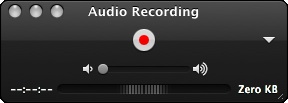Mac 101: QuickTime Player

How to use QuickTime Player to play media files on your Mac
QuickTime Player is a great application for playing media content, including HD (high definition) video in OS X. QuickTime Player supports many modern codecs and file formats, so simply double-click your media file in the Finder and it will open in QuickTime Player. If a media file doesn't automatically open in QuickTime Player by double-clicking it, you can choose the Open File option from the File menu, browse to the file's location, and select it. Additionally, you can open a streaming media file (or event) by clicking the File menu and then choosing Open Location and entering the Internet address (the URL) for the movie file.
The playback controls in QuickTime Player work simply with Rewind and Fast Forward buttons, and with the Play button handling both playback and stopping.

The timeline at the very bottom of the player shows your current viewing progress and can be dragged (left or right) to move to a desired position or time by using the mouse. This is helpful for moving through lengthy media files, especially when searching for a specific moment or event. The total playback time remaining is listed on the bottom-right corner of the playback controls when the controls are open. If you want to see the lenght of the clip, just click on the time remaining.
Full-screen in QuickTime
QuickTime Player use the full-screen features built-in to OS X to give you maximum screen viewing space of your movies or clips. To make QuickTime Player fill your entire screen, click the full-screen button, which is located on the top-right of the playback controls or in the top-right of the QuickTime Player window with two arrows pointing outwards. While you are in full screen you can switch to another app without leaving full-screen by swiping left or right using three fingers. The menu bar will appear if you move the mouse pointer to the top of the screen. From there, you can click the View menu and select one of several scaling modes to find the perfect fit for you display. To make the screen go back to it's original size, simply click the Full Screen button once again or press Escape (esc).
Supported media file formats
QuickTime Player supports a wide variety of popular audio and video file formats and codecs. To learn more, see Media formats supported by QuickTime Player.
About Audio and movie recording in QuickTime Player
You can make a movie using QuickTime Player and the camera in your Mac by clicking the File menu and choosing New Movie Recording. When the recording interface appears, the FaceTime or iSight camera becomes active (a green light appears by your Mac's built-in camera). Simply press the circular record button once to start or stop your recording.
Clicking the triangle icon gives you additional options, such as letting you choose whether to use the built-in iSight camera an external camera you've connected to your Mac, and lets you adjust the finished quality of your recording.

To make an audio-only recording, simply choose New Audio Recording from the File menu. Press the circular record button once to start or stop your recording. You will notice that the current running file size is displayed on the bottom right of the controls while you're recording; this changes to the total elapsed time when you stop recording. The sound meter (located at the bottom of the controls) makes it easy to ensure your volume level is consistent, and is helpful for making sure you're sitting an appropriate distance from the microphone. About 21 inches of distance between you and the microphone is a good place to start.

Clicking the triangle gives you additional options, such as letting you choose whether to use the built-in microphone on your Mac, an external microphone you've connected to your Mac, a microphone from a connected Apple display, and lets you adjust the finished quality of your recording.
Tip: Changing the quality from High to Maximum will produce a very high-quality uncompressed movie file. However, uncompressed audio files can use large amounts of disk space.